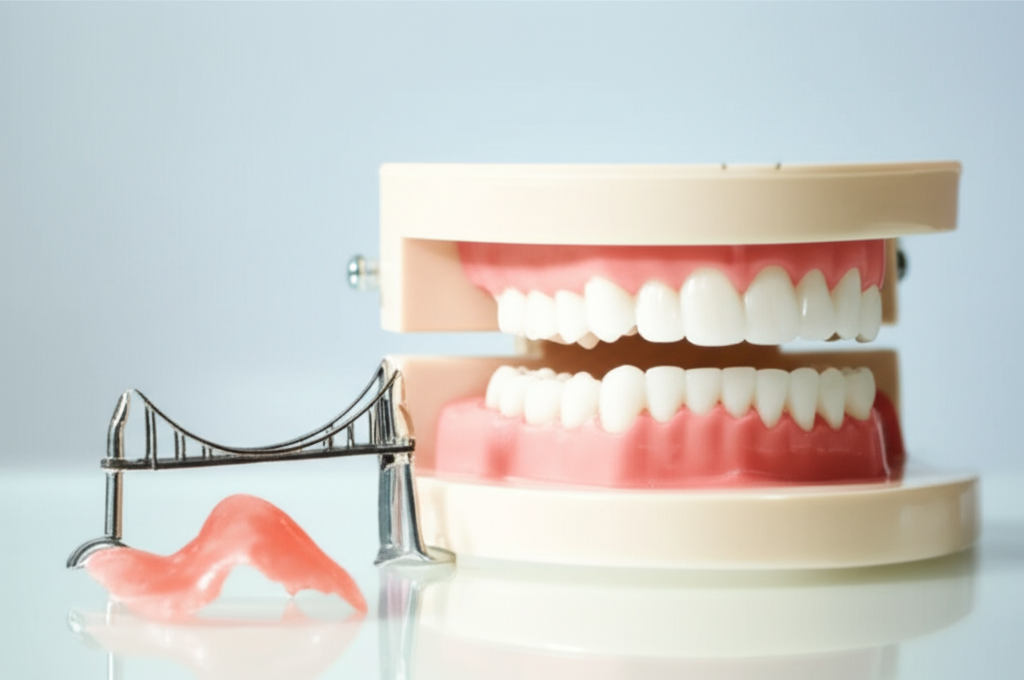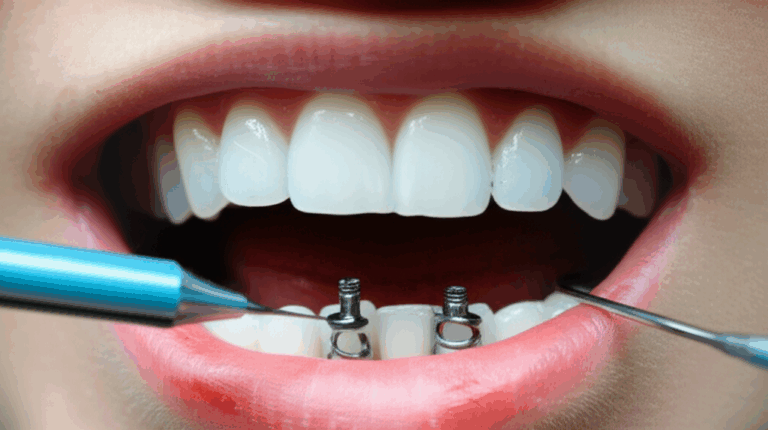
Beyond Implants: Exploring Effective Alternatives for Missing Teeth
Table of Contents
- What Are Removable Partial Dentures?
- Types of RPDs
- Pros of Removable Partial Dentures
- Cons of Removable Partial Dentures
Introduction: Why Consider Alternatives to Dental Implants?
If you’re missing a tooth or two, you know it can mess with your smile, your confidence, and how you eat or talk every day. Picking the best way to fix it is a pretty big deal. I remember sitting there in my dentist’s chair, kind of overwhelmed by all the choices. Dental implants sounded awesome—everyone says they’re the best, right? But then the cost came up. Then the surgery part. And I learned my jawbone wasn’t great for it anyway.
That’s why so many people, like me, end up looking for something else. Maybe you can’t afford implants right now or you can’t have surgery because of health reasons. Sometimes, you just want something easier and not so fancy. That’s what this guide is for—to show you the main choices besides dental implants, using what I learned myself along the way.
Dental Bridges: A Fixed Solution
What Is a Dental Bridge?
Let’s start with dental bridges since that was the first other choice I thought about. A dental bridge is a fixed fake tooth (or teeth) that fills the gap where your real tooth is missing and uses the teeth on either side for support.
Imagine a little bridge going over water—your healthy teeth are the supports, and the fake tooth sits in the middle. The best bit? A bridge isn’t something you take out every night. It’s glued in and stays there.
Types of Dental Bridges
I was kind of surprised by how many types there are. Here’s what my dentist told me:
- Traditional Bridge: The usual one—your dentist shaves down the two teeth next to the gap and puts crowns on them with your new tooth stuck between.
- Maryland Bridge: Also called a bonded bridge. It has “wings” that stick to the back of your neighbor teeth. It’s less work on your good teeth, but works best for front teeth.
- Cantilever Bridge: Used when you only have one tooth next to your gap. Not as common, but works sometimes.
All are fixed in place, but each is picked for different reasons.
Pros of Dental Bridges
Some reasons I liked bridges more than implants:
- They’re fast. Usually takes just weeks.
- No surgery needed. A big deal for scaredy-cats like me.
- Works well almost right away. You can eat, talk, and smile again.
- Usually cheaper than implants.
Cons of Dental Bridges
But there are some negatives, too:
- Your good teeth get drilled down. That’s permanent—you can’t undo it.
- Doesn’t help bone loss. The bone underneath can still shrink since there’s nothing to “work out” the jaw.
- Cleaning underneath is trickier. Takes some practice not to have food stuck under there.
- Doesn’t last as long as implants. Most last 5–15 years if you take care of them.
If you want to learn more about how these are made, check out a crown and bridge lab—having a good one matters for how good your bridge looks and lasts.
Removable Partial Dentures (RPDs): Flexible and Accessible
What Are Removable Partial Dentures?
When you hear “partial denture,” you might think of your grandparents, but actually, they’re not too bad. Removable partial dentures are fake teeth on a base that fill in the spots where you’ve lost teeth. You take them out yourself to clean them or at bedtime.
They’re good if you’ve lost a few teeth here and there, not the whole set.
Types of RPDs
Here’s what my dentist told me:
- Cast Metal Partials: Strong and slim, with metal hooks that hold onto your real teeth.
- Acrylic (Plastic) Partials: The cheaper, plastic ones. Not as strong but fast and cheap if you need something quick.
- Flexible Partials (like Valplast): Made out of bendy plastic. They don’t have metal so they look better and feel softer on your gums.
Want to know how they’re made? There’s some cool info at a removable denture lab.
Pros of Removable Partial Dentures
What I liked most:
- No surgery and doesn’t mess up your other teeth.
- Low cost. Definitely less pressure money-wise.
- Get them fast. Sometimes in just a week or two.
- Easy to clean. Just pop them out and wash.
Cons of Removable Partial Dentures
But, not perfect:
- Not as steady. They can wiggle, especially when eating sticky stuff.
- Takes time to get used to. Talking and eating felt weird at first.
- Might make your gums sore. My dentist had to adjust mine a bit to fit.
- Don’t last forever. Usually 5–10 years before you need a new one or changes.
If you want something comfy or that blends in, ask about the flexible or Valplast kinds. I thought they felt much better!
Full Dentures (Complete Dentures): For Total Tooth Loss
What Are Full Dentures?
Full dentures are for when you’ve lost all your teeth on the top or bottom (or both). At first, this sounded scary, but they really help people who have no teeth from aging, gum disease, or tooth decay.
Types of Full Dentures
From what I learned:
- Regular Dentures: Made after your gums heal from having teeth pulled. They fit better once you’re healed up.
- Immediate Dentures: Made before teeth are out and put in right after pulling. You don’t go without teeth at all, but need more fixes as your gums shrink and heal.
Pros of Full Dentures
- No surgery. Just impressions of your mouth.
- Cheaper when you lose lots of teeth.
- Let you eat and smile again.
- Can upgrade later. If you want implants someday, you can still do it.
Cons of Full Dentures
- Sometimes not very stable. Bottom ones especially can move when you eat or talk.
- Jawbone shrinks over time. Makes dentures loose later on.
- Need regular fixes. Adjusting or relining to keep them comfy.
- Not great for biting tough stuff. I couldn’t manage steak or apples easily.
If you want to see how new dentures are made to look more natural, newer stuff from a modern digital dental lab can really look and feel better.
Other Considerations & Temporary Solutions
Dental Flipper
The very first time I lost a front tooth, I worried about walking around with a gap. Dental flipper to the rescue. It’s a light, acrylic fake tooth you pop in. Not for chewing tough stuff, but great while you’re waiting on something more solid.
No Treatment
You might just want to ignore the gap, but that’s hardly ever a good idea. Teeth can drift, your bite can get messed up, and the bone below can shrink, too. That ends up costing more to fix later, like I found out. There are very few good reasons to “just wait.”
Factors to Consider When Choosing an Alternative
After lots of reading and trying a couple things myself, here’s what I think you should think about:
Cost
Implants cost a lot at first, but bridges and dentures need repairs and new ones sometimes. Think about both what you pay now and what it costs over the years.
Longevity & Durability
Implants can last a really long time; bridges might last 5–15 years, dentures about 5–10. How well you clean them makes a difference, too.
Oral Health Impact
Bridges need your neighbor teeth to be drilled and capped. Partials are easier on your other teeth, but don’t help your bone. Implants help your bone the most, but aren’t right for everyone.
Aesthetics & Comfort
Bridges and flexible partials look the best. Dentures and flippers look better nowadays but don’t always feel like real teeth. If you can try one out, you should.
Functionality
If you love crunchy food, be honest with your dentist. Bridges and implants feel the most like real teeth. Removables are pretty good for most foods, but not perfect.
Maintenance & Care
Bridges need careful cleaning. Dentures should be soaked and scrubbed after eating. If that sounds like too much work, talk to your dentist about easy-clean options.
Medical Considerations & Personal Preferences
Health problems or medicines can make implants or surgery a no-go. Don’t be scared to say what’s most important to you.
Consulting Your Dentist: Making an Informed Decision
No matter how much you read online, nothing beats talking with a dentist you trust. What looks perfect in articles sometimes doesn’t work well for your mouth or health.
- Get checked out. Your dentist will look at more than just the gap—even your gums and jaw matter.
- Personal plan. There’s no “one-size-fits-all.” A good dentist will help make a plan that fits your mouth, budget, and health.
- Second opinions help. If you’re not sure, ask another dentist.
- Teamwork. Some dentists work with special china dental labs to get the best fit and look.
A pro can also spot things you miss, like early gum trouble or jawbone shrinking, so your solution lasts longer.
Conclusion: Finding Your Best Tooth Replacement Option
Every time I lost a tooth, the “best” fix was different, depending on money, my health, and what I could handle. What works for one person probably isn’t right for everybody. Main point—dental implants are great, but not your only choice. Bridges, partials, flippers, and full dentures can all give you back your smile and your bite.
Take some time. Weigh your needs. Talk to your dentist. Don’t rush. The most important thing: you feel good with your choice and aren’t left in the dark.
If you want to learn more about how these are made or what they look like behind the scenes, take a look at a removable denture lab or crown and bridge lab.
And don’t wait to have a chat with your dentist. Your best option is out there—you just need to find what fits you best so you can chew, smile, and live your life your way.








